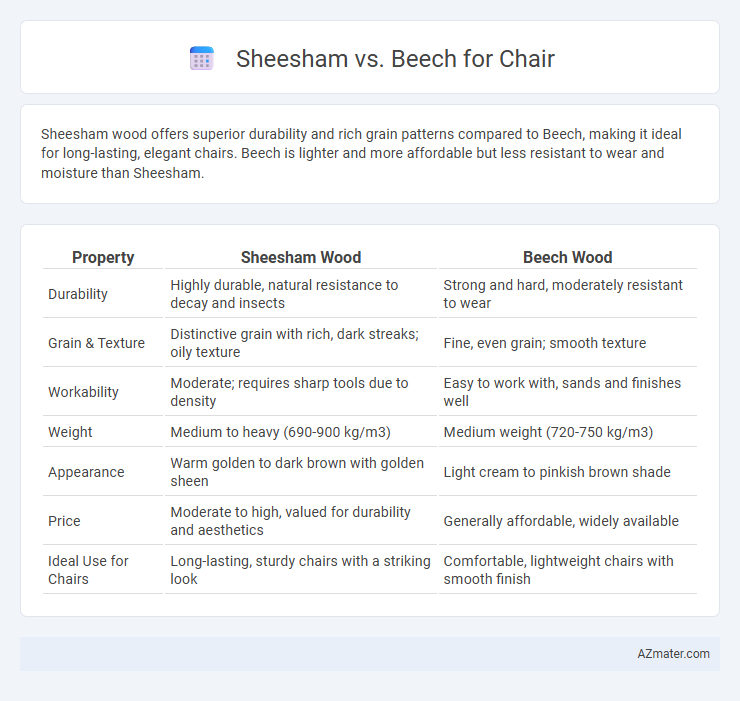Sheesham wood offers superior durability and rich grain patterns compared to Beech, making it ideal for long-lasting, elegant chairs. Beech is lighter and more affordable but less resistant to wear and moisture than Sheesham.
Table of Comparison
| Property | Sheesham Wood | Beech Wood |
|---|---|---|
| Durability | Highly durable, natural resistance to decay and insects | Strong and hard, moderately resistant to wear |
| Grain & Texture | Distinctive grain with rich, dark streaks; oily texture | Fine, even grain; smooth texture |
| Workability | Moderate; requires sharp tools due to density | Easy to work with, sands and finishes well |
| Weight | Medium to heavy (690-900 kg/m3) | Medium weight (720-750 kg/m3) |
| Appearance | Warm golden to dark brown with golden sheen | Light cream to pinkish brown shade |
| Price | Moderate to high, valued for durability and aesthetics | Generally affordable, widely available |
| Ideal Use for Chairs | Long-lasting, sturdy chairs with a striking look | Comfortable, lightweight chairs with smooth finish |
Introduction to Sheesham and Beech Wood
Sheesham wood, also known as Indian Rosewood, is prized for its rich grain patterns, durability, and natural resistance to decay, making it ideal for crafting sturdy, long-lasting chairs. Beech wood features a light color with a fine, tight grain, known for its hardness and shock resistance, providing excellent support and comfort in chair construction. Both woods offer unique aesthetics and functional qualities, with Sheesham delivering a darker, more decorative finish and Beech emphasizing strength and a smooth texture.
Origin and Availability of Sheesham vs Beech
Sheesham, or Indian Rosewood, originates primarily from the Indian subcontinent, with abundant forests in India and Nepal, making it a readily available hardwood in South Asia. Beech wood is native to Europe and North America, commonly found in temperate forests, ensuring strong regional availability in these areas. The differing geographic origins influence the availability and supply chain of these woods for chair manufacturing worldwide.
Visual Appearance and Grain Patterns
Sheesham wood showcases rich, dark brown tones with golden streaks that enhance the chair's luxurious and warm visual appeal, while its grain patterns vary from straight to wavy, offering dynamic texture and depth. Beech wood features a lighter, creamy color with a subtle pinkish hue, providing a clean, modern look that brightens chair designs. Its fine, straight grain pattern delivers a smooth, uniform appearance, ideal for minimalist and contemporary furniture styles.
Durability and Strength Comparison
Sheesham wood, native to India and known for its dense grain, offers superior durability and resistance to decay compared to Beech wood, which is commonly found in Europe. The natural oils in Sheesham enhance its strength and make it highly resilient against pests and moisture, ideal for long-lasting chairs. Beech wood provides good strength and hardness but is more prone to wear and less resistant to environmental factors than Sheesham.
Workability and Crafting Ease
Sheesham wood offers excellent workability due to its medium density and smooth grain, making it easier to carve and shape for detailed chair designs. Beech, known for its fine, tight grain and hardness, provides superior crafting ease when machining and bending, ideal for ergonomic chair frames. Both woods balance durability with workability, but Beech tends to deliver more precision and a smoother finish in mass production settings.
Comfort and Ergonomics in Chair Making
Sheesham wood offers superior durability and natural resistance to wear, providing long-lasting support and stability in ergonomic chair designs. Beech wood is favored for its flexibility and smooth finish, allowing for comfortable contours and gentle curves that enhance seating comfort. Both woods contribute to ergonomic chair making, but Sheesham excels in sturdy, supportive frames while Beech is ideal for sculpted, user-friendly seating surfaces.
Maintenance and Longevity
Sheesham wood offers higher resistance to moisture and insects, requiring less frequent maintenance compared to Beech, which is more prone to warping and cracking without proper care. Beech chairs may need regular polishing and sealing to maintain durability, while Sheesham's natural oils enhance longevity and reduce upkeep. Overall, Sheesham is preferred for long-lasting chairs with minimal maintenance, especially in humid environments.
Environmental Impact and Sustainability
Sheesham wood, sourced from Dalbergia trees, is known for its durability and carbon sequestration properties, making it a more sustainable choice when harvested responsibly from managed forests. Beech wood, while fast-growing and abundant, often involves more intensive chemical treatments during processing, which can increase its environmental footprint. Choosing Sheesham furniture supports longer-lasting use and contributes to reduced deforestation rates if certified by sustainable forestry programs.
Cost Analysis: Sheesham vs Beech
Sheesham wood chairs typically cost more due to the hardwood's natural durability, rich grain patterns, and higher demand in premium furniture markets. Beech wood chairs are generally more affordable, offering moderate strength and easier machining, which reduces manufacturing expenses. Comparing the two, Sheesham provides long-term value with its resilience despite a higher initial investment, while Beech suits budget-conscious buyers seeking cost-effective options.
Best Choice for Chairs: Recommendations
Sheesham wood offers durability, rich grain patterns, and natural resistance to termites, making it an excellent choice for long-lasting chairs with elegant aesthetics. Beech wood provides a lighter, smoother finish with strong shock resistance and affordability, ideal for chairs that require a sleek look and comfortable seating. For premium, sturdy furniture with intricate designs, Sheesham is recommended, while Beech suits budget-conscious users who prefer lightweight and easily maintainable chairs.

Infographic: Sheesham vs Beech for Chair
 azmater.com
azmater.com